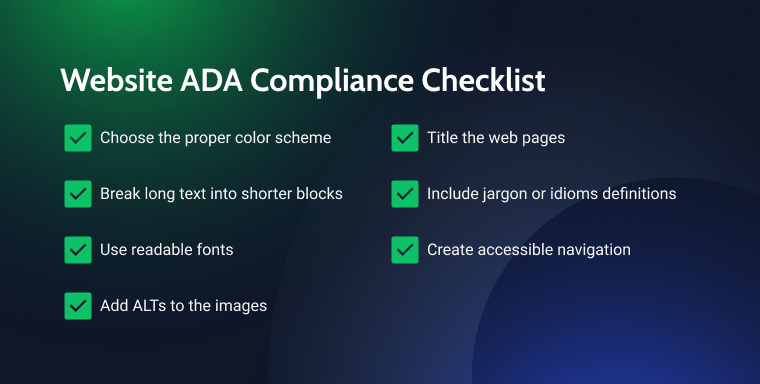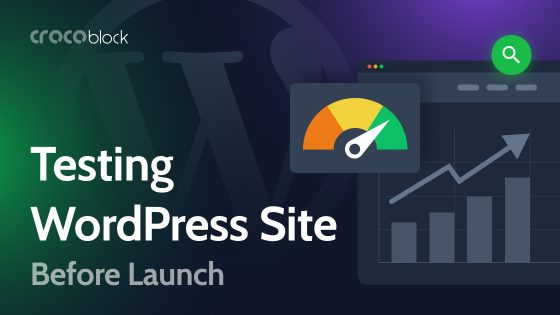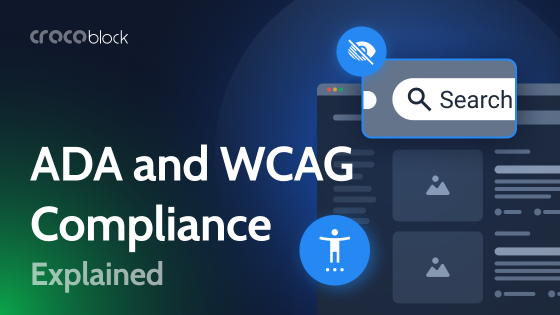You finally did it. From the conception of a design and product mockups to your eCommerce store launch through WordPress – your new small business is off the ground and destined for greatness.
Then you get an email from some law firm – you’re getting sued for ADA noncompliance on WordPress. You don’t even know what ADA stands for or how to comply with it. Surely this is a mistake?
Not so fast.
Table of Contents
Creating Compliance
The Americans with Disabilities Act, or ADA, exists to provide disabled Americans the same equity and opportunities as the rest of America. It includes freedom of employment and access to government services alongside most other standard civil rights measures. It also has strict but nuanced regulations for private businesses.
Much confusion and struggle arise from Title III of the ADA, which broadly guarantees accessibility to disabled Americans. That’s why multi-story buildings have elevators, handicap parking is mandatory, and all elevated steps or concrete have a ramp available. But, since the ADA was passed in 1990, no provision exists to define access to the internet, and much consternation arose from that historical omission that continues today.
Unlike government mandates like ensuring HIPAA compliance, Title III is loosely written. And, since so many law firms are looking for an easy win and quick buck, predatory lawyers representing disabled Americans mass-target websites that don’t “provide access” to disabled Americans.
These firms interpret the phrase “accessible electronic and information technology” as extending to apps and the internet. Subsequently, a fifth of all ADA lawsuits focus on website accessibility and these are lawsuits brought to federal court, not accounting for the uncountable letters and rackets these firms use to threaten and extort small business owners and website administrators.
Luckily, resources exist to avoid this pitfall, and WordPress is a repository of quality ADA services, features, and benefits.
Proactive WordPress plugins
One of the benefits of using WordPress is the breadth and depth of plugin options. Whatever feature or function your site needs, someone has probably already created a plugin to service the market.
There are many free and paid options on WordPress. Still, the WP ADA Compliance Check plugin is one of the most comprehensive. While the plugin won’t fix problems for you, it does run a complete scan of your site and pages and tells you precisely what ADA compliance problems exist and how to improve them.
Visual Validity
As you can imagine, much of the impetus behind ADA compliance on your WordPress site centers around sensory disabilities like sight.
Because of this, you’ll need to focus on how your WordPress site looks and acts. Besides the evident aesthetic impact and selection to suit your broader audience, you’ll also need to consider your sight-impaired visitors.
Remember – we’re all digital citizens now, and we should treat each other online as we’d treat each other in person. Thus, ensuring online safety and access is a priority, and your page design should reflect this.
If you remember the early days of personal blogs and sites, you likely remember eye-bleeding yellow text on red background or the classic Matrix green-on-black vibe. Thankfully, those days are past us, but although most people have no problem reading text on a website, the visually impaired aren’t so lucky.
Tips to comply with the ADA
- Look very closely at the color scheme and if it makes text or graphics bleed into the background without 20/20 vision.
- It would be best to keep long-form text tight and almost choppy. Avoid long, rambling paragraphs and keep blocks of text to around 5-7 sentences with no more than ten words per line. Believe it or not, this also increases engagement amongst the mainstream audience.
- Would you rather squint with your phone against your face or lean back and enjoy reading blog posts? Keeping text tight will make reading your content enjoyable for everyone.
- For those with more severe visual impairments, you need to include “ALT” text for images. ALT text is simply a background textual description of an image that can be read aloud by software for blind readers and create an immersive experience.
ALT text has other benefits too. For example, if the site doesn’t load properly, then the ALT text will display and give readers an idea of what they’re missing. ALT text also improves your SEO by providing search engines with short, actionable, and crawlable keywords to reference when returning results.
Above and Beyond
The Web Content Accessibility Guidelines, or WCAG, are a series of non-binding but highly recommended additional website accommodations for disabled persons. While they are more strict than the letter of the law in the ADA, complying with the WCAG is a surefire way to guarantee compliance and, more importantly, give your audience a first-class experience irrespective of personal circumstances.

Here are a few important overlooked traits based on WCAG guidance to check off on your WordPress site today (make sure to check out the complete list to maximize your site’s equity and equality):
- For any scrolling, blinking, or moving information that either lasts longer than five seconds, starts automatically, or is presented together with other content, ensure there is a way for visitors to stop, pause, or hide it unless the scrolling, blinking, or movement is part of the essential activity.
- When an authenticated session expires, the visitor can continue browsing your site without losing any data after re-authenticating.
- Your website doesn’t contain any content that flashes over three times in any one-second period.
- Web pages have titles that describe the topic or purpose.
- A mechanism can be used to identify definitions of words or phrases used in a restricted or unusual way, including jargon and idioms.
- A mechanism is available for identifying the expanded form or meaning of abbreviations.
- There is a way to identify specific pronunciations of words where their meaning is unclear without knowing the exact pronunciation.
FAQ
According to the ADA National Network (ADANN), “the ADA defines a person with a disability as a person who has a physical or mental impairment that substantially limits one or more major life activities.”
Unfortunately, your best bet is to consult with the very lawyers who make a living off of ADA-based website lawsuits. Chances are if they can’t find anything, you’re golden. The ADA doesn’t give attorney referrals, but the National Disability Rights Network, a nonprofit, can likely point you in the right direction.
If you’re curious about how your audience accesses your site or want to optimize for standard tools, the ADANN has an extensive listing on this topic.
Conclusion
Look – yes, avoiding a lawsuit and getting your eCommerce empire growing on WordPress is ideal. But think about the other side of the screen. If you, or a loved one, were visually impaired, would you want to be effectively restricted from today’s primary communication and information tool?
Not likely.
Do the right thing – foster an equitable community and ensure compliance.

